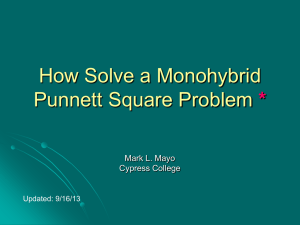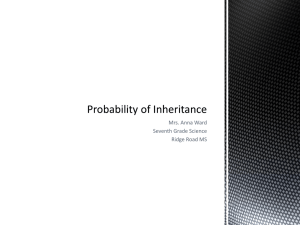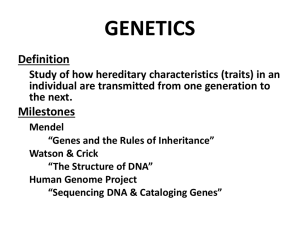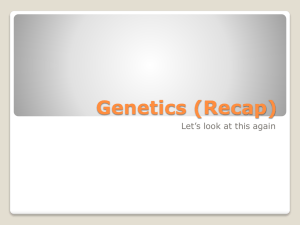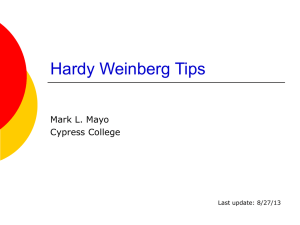Document
advertisement
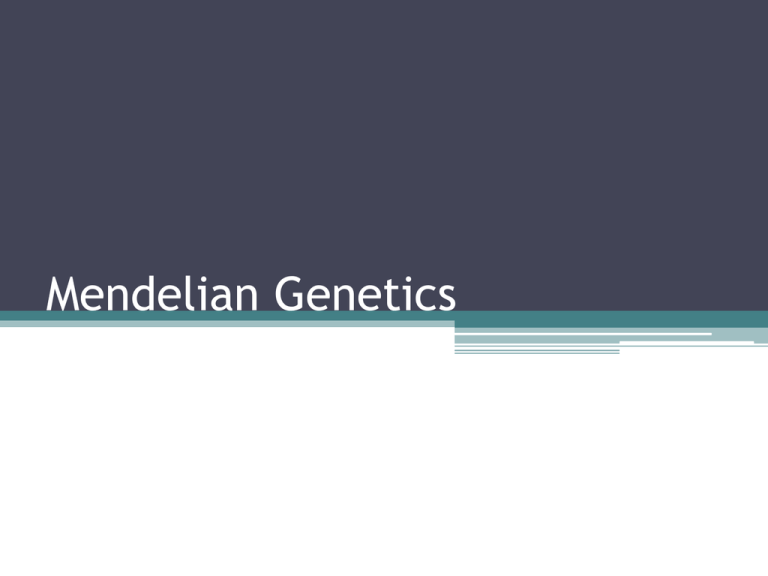
Mendelian Genetics Gregor Mendel • Austrian Monk • Cross breed different varieties of pea plants in order to create new characteristics • Kept records and ratios of thousands of offspring • Found specific ratios which led him to believe that each fertilization had a chance outcome with a certain probability Gene: • Hereditary units for specific traits that are found on a specific location (locus) on a chromosome • Diploid cells have a pair of genes for each trait, on a pair of homologous chromosomes • NON-DUPLICATED HOMOLOGOUS CHROMOSOMES Allele: • Different molecular forms for the same trait Dominant Allele • A trait that is always expressed • Masks recessive traits • Expressed as capital letters, ex: A Recessive Allele • A trait that is only expressed when both alleles are recessive • Expressed as lower case letters, ex: a Homozygous: • When both alleles are the same • Ex: AA (homozygous dominant) or aa (homozygous recessive) Heterozygous • Having two alleles for different traits • Aa Genotype • The genetic make up or code of an organism (can not see) Phenotype • The physical expression of ones genotype • (can see) Mendel’s Pea Traits: Mendel’s Pea Traits Trait: Dominant: Recessive: Seed Shape Round – R Wrinkled – r Seed Color Yellow – Y Green – y Pod Color Green – G Yellow – g Stem Length Tall - T Short - t Mendel’s Pea Traits Genotype Phenotype Homozygous or Heterozygous TT Tall Stem Homozygous Dominant Yy Yellow Seeds Heterozygous Rr Round Seeds Heterozygous gg Yellow Pod Homozygous Recessive YY Yellow Seeds Homozygous Dominant rr Wrinkled Seeds Homozygous Recessive Tt Tall Stem Heterozygous Write in the possible genotypes: Punnett Square • Method of predicting the probable outcome of a genetic cross Monohybrid Cross: Rr & Rr R r R RR Rr r Rr rr • Genotype Ratio: 1:2:1, Alleles from each parent are brought down, remember alleles from each parent are split into gametes during meiosis. Each allele is brought down into the boxes to form the possible genotypes of the offspring Homozygous Dominant:Heterozygous: Homozygous Recessive • Phenotype Ratio: 3:1, Round:Wrinkled • Therefore there is a 75% chance of having offspring with round seeds and 25% chance of wrinkled seeds Dihybrid Cross: RrGg vs. RRgg RrGg vs. RRgg RG Rg rG rg Rg RRGg RRgg RrGg Rrgg Rg RRGg RRgg RrGg Rrgg Rg RRGg RRgg RrGg Rrgg Rg RRGg RRgg RrGg Rrgg Practice: 1. 2. 3. 4. 5. Heterozygous round versus wrinkled Homozygous yellow seed versus green Homozygous tall plant versus a homozygous short plant Wrinkled seed plant versus a heterozygous round seed plant A homozygous tall with homozygous yellow seeds versus a homozygous short with homozygous green seeds 1. R r 2. Y Y r Rr rr y Yy Yy r Rr rr y Yy Yy 3. T T 4. R r t Tt Tt r Rr rr t Tt Tt r Rr rr 5. TY TY TY TY ty TtYy TtYy TtYy TtYy ty TtYy TtYy TtYy TtYy ty TtYy TtYy TtYy TtYy ty TtYy TtYy TtYy TtYy Practice: • TtYy vs. TtYy • State the genotype and phenotype ratios in addition to a punnett square • Genotype Ratios: • 1 TTYY, 2 TTYy, 2 TtYY, 4 TtYy, 2 Ttyy, 2 ttYy, 1 TTyy, 1 ttYY, 1 ttyy • 1:2:2:4:2:2:1:1:1 • Phenotype Ratios: • 9 tall with yellow seeds, 3 short with yellow seeds, 3 tall with green seeds, 1 short with green seeds • 9:3:3:1 TY Ty tY ty TY TTYY TTYy TtYY TtYy Ty TTYy TTyy TtYy Ttyy tY TtYY TtYy ttYY ttYy ty TtYy Ttyy ttYy ttyy Pedigree • A method of genetic analysis using a family tree like diagram • Used to trace and predict outcomes of offspring Recessive because it would have shown through here Ll or LL Ll ll ll Ll Ll Ll Ll Ll or LL ll 1. 2. Ll ll Ll Pedigree Practice Problem: Ll ll Is lung disease dominant or recessive? How do you know? Label as many people as possible with their genotypes

